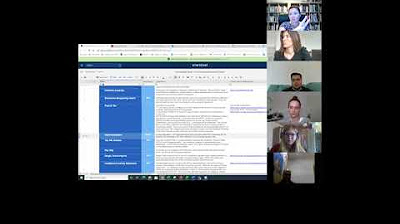Training Session 14 05 02 2021 Payroll 2 Payroll tax 15
Summary
TLDRThe video script discusses payroll tax, a state-specific tax levied on employers, highlighting its monthly calculation and the importance of timely payment by the 7th of each month. It also touches on the impact of COVID-19 on tax thresholds and the necessity to stay updated with state revenue offices. The script further explains Fringe Benefits Tax (FBT), which targets non-cash benefits provided to employees, emphasizing its complexity and the highest marginal tax rate applied. The speaker stresses the importance of accurate FBT calculations and staying informed about tax changes.
Takeaways
- 📊 Payroll tax is a state-specific tax levied on employers, with varying rates depending on the state.
- 🗓 Payroll tax is calculated on a monthly basis and must be paid by the seventh of each month.
- 💻 There is usually an online portal for uploading payroll information and making the tax payment.
- 🔑 Payroll tax includes payments for wages, superannuation, and any applicable fringe benefits tax (FBT).
- 💡 FBT is a tax on non-cash benefits provided to employees, such as gym memberships or school fees, meant to deter employers from avoiding regular payroll taxes.
- 🔄 The threshold for FBT has recently changed due to the impact of COVID-19, with adjustments in different regions.
- 📈 FBT is taxed at the highest marginal rate, which can be as high as 47%, to discourage employers from offering such benefits.
- 🔍 It's important to verify information and check state-specific websites for the most current tax regulations, especially with changes due to COVID-19.
- 🚫 FBT can apply to a wide range of benefits, including meals, parking, and even company cars, making it complex and requiring careful accounting.
- 🛠 For smaller clients, FBT may not be a concern, but for larger clients, it's crucial to be aware of different coding methods and FBT calculation approaches.
- 📚 Training on FBT will be provided when necessary, ensuring that individuals are equipped with the knowledge to handle FBT-related tasks.
Q & A
What is the nature of payroll tax according to the transcript?
-Payroll tax is a state-by-state tax levied against employers, varying in rate depending on the state. It is calculated on a monthly basis and must be paid by the seventh of each month.
How is payroll tax typically handled in practice?
-Payroll tax is usually calculated and paid through an online portal where all the necessary information is uploaded and the amount due is paid on wages, superannuation, and any applicable fringe benefits tax.
What is the significance of the threshold mentioned in the context of payroll tax?
-The threshold, which is subject to change, determines the amount of wages below which payroll tax may not be applicable. As of the transcript's information, it was recently changed to 1.2 million due to the impact of COVID-19.
What is the importance of checking the Office of State Revenue website?
-Checking the OSR website is crucial to stay updated on any changes in payroll tax regulations, ensuring that calculations and payments are accurate and up-to-date.
What is Fringe Benefits Tax (FBT) and why was it introduced?
-Fringe Benefits Tax is a tax on non-cash benefits provided to employees, introduced to prevent employers from avoiding pay-as-you-go tax and superannuation by offering employment benefits instead of salary.
How is the tax on fringe benefits calculated?
-Fringe benefits are taxed at the highest marginal rate, which means they are 'grossed up' to the value they would have if the employee had received the money as salary and then paid tax on it.
What are some examples of fringe benefits mentioned in the transcript?
-Examples include paying for an employee's wife's gym membership, children's school fees, or providing free parking within a certain distance from the workplace.
Why is it important to be cautious with FBT calculations?
-FBT calculations are complex and can be high risk; therefore, it's important to verify information and not rely solely on outdated notes or assumptions to avoid errors.
How can one stay informed about changes in tax regulations due to events like the coronavirus pandemic?
-By regularly visiting state tax websites and scanning for updates, one can keep abreast of changes in tax regulations and initiatives that may affect payroll and fringe benefits tax.
What advice is given for handling tax calculations when there is uncertainty or risk?
-The advice given is to always check the latest information on the relevant tax authority's website before proceeding with calculations, especially when dealing with high-risk tax areas.
What is the implication for smaller clients regarding FBT?
-For smaller clients, FBT may not be relevant or necessary to worry about, but it's important to be aware of it in case it becomes applicable in the future or for larger clients.
Outlines

This section is available to paid users only. Please upgrade to access this part.
Upgrade NowMindmap

This section is available to paid users only. Please upgrade to access this part.
Upgrade NowKeywords

This section is available to paid users only. Please upgrade to access this part.
Upgrade NowHighlights

This section is available to paid users only. Please upgrade to access this part.
Upgrade NowTranscripts

This section is available to paid users only. Please upgrade to access this part.
Upgrade NowBrowse More Related Video

Teori Pemungutan Pajak | MOOC | Materi Pengantar Perpajakan Seri 3

Session 3 - 03 Payroll, Modern Award Superannuation Paygi and PAYG

Tax Differences EXPLAINED: LLC, S Corp, Partnership, Sole Prop

Curso Básico Contpaqi Nómina. Como dar de alta a un empleado.

【即やるべき】「こんなに差が付くなんて…」個人事業主必見。確定申告後すぐにやった方が良い節税の事前対策について解説!

Sistematika Ketentuan Umum dan Tata Cara Perpajakan (KUP)
5.0 / 5 (0 votes)